The First Couple of Bull Riding
By: Andrew Giangola
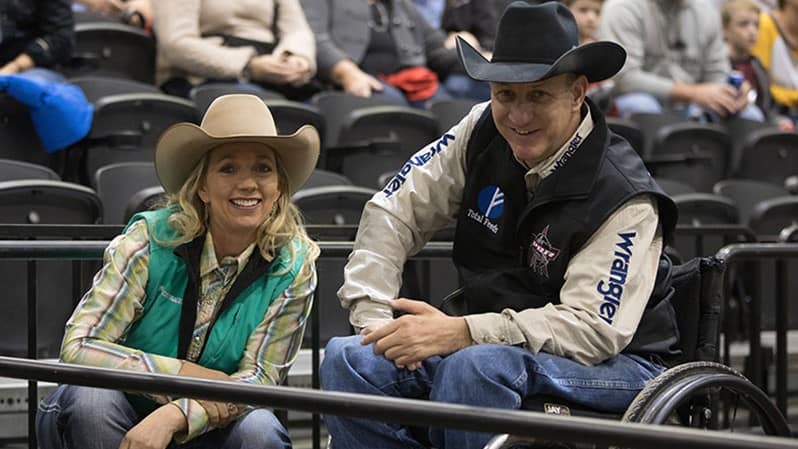
Tiffany and Jerome Davis recently made news in PBR circles when Jerome was named coach of the Carolina Cowboys with Tiffany as assistant general manager of the new bull riding team in the PBR Team Series. Last weekend, the couple hosted yet another successful crowd-pleasing PBR event – for the 23rd straight year – at the Davis Rodeo Ranch in Archdale, N.C.
As the couple now prepares for the Carolina Cowboys’ inaugural homestand on Sept. 9-11 at LVJ Memorial Coliseum in Winston-Salem, we want to bring you their incredible story of love, faith and grit, published in a new book, “Love & Try: Stories of Gratitude and Grit from Professional Bull Riding.” Book proceeds support injured bull riders through the Western Sports Foundation, an organization founded as the Rider Relief Fund following Jerome’s bull-riding accident in the late 1990s.
When PBR swings through North Carolina, fans have the opportunity to get a down-home insiders’ look at big-time bull stock contracting by visiting the Davis Rodeo Ranch in Archdale, N.C.
Bull riding enthusiasts and newbies alike are welcomed with open arms by two beloved figures in the sport, who, when Jerome Davis’ career was cut short by injury, turned to raising bucking bulls to compete in the PBR, hosting smaller events in their own arena, and housing and training bulls for outside partners.
At the Davis Ranch, fans are made to feel right at home, getting a soup-to-nuts education on these animals – along with a scrumptious home-cooked Carolina meal and plenty of laughs as they tour the couple’s sun-drenched 100 acres in golf carts driven by Jerome and Tiffany.
On these tours, fans board carts for a bumpy ride along a bucolic path cutting through the ranch’s rolling pastures. At periodic stops, Tiffany will bound out, step onto the grass ridge, and loudly introduce each bull, finding a way to veer off onto hilarious riffs, like getting engaged to a young, rising bull rider.
As told by Tiffany on one such outing: “I started off as a buckle bunny,” she joked. “No, to be serious, I was raisin’ bulls early. I knew Jerome since high school. I worked at Pizza Hut; instead of a car payment, I had a cow payment. Girls, the way to get a cowboy is not through cookin’. It’s through cows. One Christmas, I gave Jerome 24 head – 12 heifers and 12 bulls. Well, Jerome and I were together for a while, and one day, Jerome says, ‘We need to get one of those engagement rings. You better go get one.’’’
A quarter-century later, the couple has a number of “children” who fans meet on the tours – in fact, about 70 of them, weighing up to 2,000 pounds each, casually roaming the ranch’s lush hills. The bulls are fed early, every morning, hot or cold, rain or shine.
“You don’t have snow days. You don’t have off days. You don’t have holidays. Bull raisin’s a 365-day-a-year job,” Tiffany said. “And these bulls eat a whole lot better and healthier than us. On the road, we eat at truck stops. They have this expensive organic feed we take. We even take our own hay. We pack the bulls’ food, and meanwhile, we grab what we can find.”
The Davises are part of a growing bull industry that has become big business as PBR has become more popular. Some top bulls are worth hundreds of thousands of dollars. When they retire, their semen can be worth up to $10,000 a straw.
The down-home folksiness of the ranch tours is a microcosm of a sport that feels like a large family traveling around the country to provide wholesome family entertainment.
Yet for all the warm informality, the animals in the sport are produced by sophisticated, high-tech breeding techniques yielding predictable bloodlines.
For the past 20 years, bucking bulls have been carefully bred like racehorses to make them more “rank.” Breeders like the Davises have at their disposal a computerized registry of about a quarter-million cows and bulls from American Bucking Bull Inc., which is jointly owned by PBR and the independent breeders. It’s the world’s second-largest animal DNA registry.
The bulls breed with cows known to have a history of producing the most powerful and fleet-of-hoof bovine athletes.
Both male and female parts of the equation are critical. Yet over the years, it has been discovered that, in this most masculine of sports, the cow is the predominant factor in producing bucking greatness. As bull breeding advances, the entire industry trains its eyes on the resulting bloodlines.
Unlike many stock contractors who buy into a promising or already proven bovine athlete, the Davises breed and raise their own bulls on their ranch.
When their bulls are ready for competition, they haul them to nearly two dozen events in PBR’s top two U.S. tours each year, including the richest and most prestigious one, PBR World Finals.
For Tiffany, speaking to the fans is a chance to set the record straight on some of the most misunderstood and unfairly maligned athletes in sports.
“These bulls don’t work for us; we work for them, and they let you know it pretty quick,” Tiffany said. “I got 70 bosses to report to every morning. Except it’s a boss that you truly love and care for.”
Fans learn about that love and care, manifested in the time and energy devoted to keeping the bulls healthy on the ranch, on the road, and in the arena.
For example, fans will notice that the bulls have flattened horns, which Tiffany explained is a result of getting their horns tipped.
“We want to keep the bulls safe from each other and, as much as we can, the cowboys safe from the bulls,” she said. “The rules say you have to be able to lay a 50-cent piece on the horn. Tipping’s like getting your fingernails cut. Takes those sharp edges off and doesn’t hurt the bull in the least.”
Like people and their hairstyles, each bull has a unique appearance and personality and horns to match.
“You see that bull over there, that bull with the downward-pointing horns?” Tiffany asked. “That’s Heartbreaker, and those are banana horns. We call him Heartbreaker because you can see a heart on his face. He’s probably broken the hearts of a few cows, too. Next to him is a muley, which is what we call bulls with no horns. Some of them are mean. Maybe there’s some resentment. We got any animal psychologists here? One of the worst hookings Jerome got was from a muley.”
Tiffany, queen of the Jerome aside, yanking a story about her husband into the PBR lesson that at times feels like unintentional stand-up comedy, does the lion’s share of the talking.
That’s just fine with her affable, laid-back husband, who was known as “The Carolina Cowboy” back in 1995 when he was the PRCA World Bull Riding Champion.
“I can’t hardly hear so I’m loud; he’s the opposite,” Tiffany explained, though most on the tour had already arrived at this conclusion. Part of her appeal to Jerome was her fireball loquaciousness and openness to accepting any new task or adventure.
She’s also very funny.
Once, when they began dating, they were driving to Georgia for a bull riding. Around 3 a.m., Jerome was getting tired.
“I said to Tiff, you take some of them NoDoz, so you can stay up and drive,” he remembered. “So, we bought some at the truck stop. She takes them with Mountain Dew. We get to Atlanta, and I wake up in the back seat and look up, and she’s driving and scratching her hair. Just scratching and scratching. I say, ‘Are you alright?!’ She says, ‘I don’t know, Jerome. It’s like I got ants in my hair. I’m all jittery. My nerves are shot!’ I think she took too many.”
Bull stock contractors will bring in chiropractors and acupuncturists, Tiffany explained. They invest in expensive cold-laser therapy devices and electro-pulse therapy to increase blood flow and loosen sore bull muscles. Bulls swim in giant pools that stock contractors install on their ranches, enjoying their own spa treatment.
“These bulls got it better than me,” she said. “I don’t get no acupuncture or lasers; I can tell you that. These bulls have had a pedicure three times since the last time I had one.”
J.B. Mauney said it another way in telling me, “This sport ain’t animal cruelty; it’s human cruelty.”
While Mauney’s comment was in jest, in his inimitable way, he was making a valid point about who gets injured and when (him…often), and how well the pampered animals who make the sport go and have helped make him the richest athlete in Western sports (over $7.4 million in earnings) are treated.
While some bulls are ornery, others are sweethearts outside the bucking chute.
Tiffany tells the story of surprising the crew when helping in the production of the film The Longest Ride.
“I was giving the bulls a bath and wiping their butts with Baby Wipes. They had the perception we keep them all mad for going into the chutes. You don’t want them wastin’ their energy and goin’ crazy! After the film shoot, the crew was hugging us, sayin’ ‘You do love these bulls! You’re makin’ it so we can enjoy this sport!’”
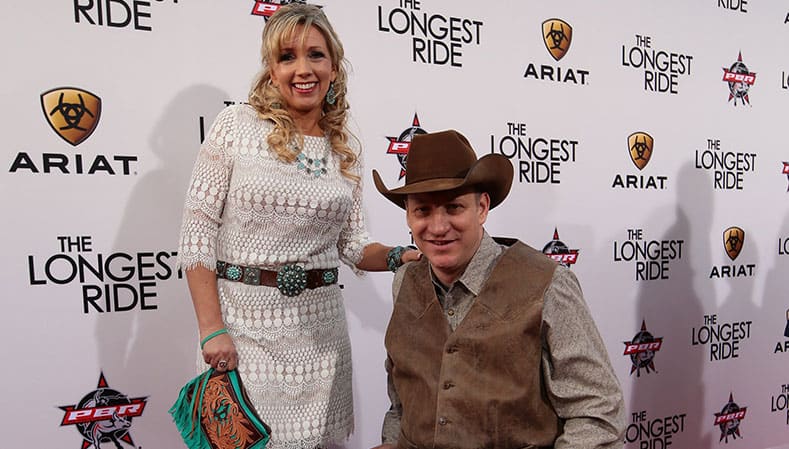
Some bulls are outgoing, attention-loving hams. Other bulls are shy and could do without people around. Many are more finicky than humans when it comes to their food and drink, giving stock contractors another way to please them.
For example, hauling bulls to World Finals in Las Vegas before the championship event’s relocation to Fort Worth, the Davis’s bulls were reluctant to drink Las Vegas water, which, beginning as snowmelt in the Rocky Mountains and then flowing into the Colorado River, tastes different than the water drawn from the groundwater tables of North Carolina.
“You want your bulls to be well-hydrated. We’ll put in a little Gatorade to encourage them to drink it,” Tiffany said.
Other stock contractors bring their own water supply for their bulls. The Davises take their own special hay on the road as well.
“They show on Instagram and whatnot the wives of the PBR packing before they leave home. I wish they showed how we pack for our bulls,” Tiffany said. “Oh, we spoil them. By the time I’ve packed for the animals, I don’t care what’s in my own suitcase.”
The bulls are well aware of the schedule when the season is in swing. They can tell when it’s time to travel.
“They see the trailer loading up, and they’re prancing around like boxers getting their game on. We call it being ‘on the muscle,’” she said.
The animals’ journey to bull housing, which is usually located 20-30 minutes from the arena, is a smooth and comfortable one. Trailers are specially equipped with “Air Ride” suspensions. Stock contractors will put 12 to 14 inches of shavings over a spongy trailer bed floor to remove shocks from the road.
Members of the Davis Ranch tours are shown how to “hang the flank” in the chutes to encourage the animal to buck when the gate flies open. They learn to tie the bull’s flank, or rope, instructed by Tiffany.
Some assume they need to tightly tie the soft cotton rope around the animal’s haunches.
“It’s not a Christmas present!” Tiffany warned. “Put it loose to encourage him to kick up, like a kitten tries to get rid of a ribbon light around her paw.”
While the flank strap encourages the bulls to kick without hurting the bull, these special animals buck first and foremost because of genetic breeding.
“Where we are today with these bulls is the result of 100 years of breeding,” Jerome said. “You can’t force a bull to do anything he don’t want to do. It’s the bred bloodlines that make them want to buck. We put a dummy on a calf and get a good idea of what he can do. That’s the beginning of a bull’s development. You see which bulls then have a natural bucking inclination, and the potential to go further.”
The Davises raise their bulls from birth. Any bull making it to the elite level of the sport generally begins their PBR career at 2 to 4 years old.
They compete for four to six years on average, then retire to stud to make more bucking bulls, enjoying a very restful, comfortable lifestyle, and generally passing of natural causes around 15 years old.
Jerome’s ever-gregarious wife greatly enjoys making people feel at home as their host. Tiffany’s casa es su casa. But her biggest motivation for doing the tours is educating anyone who’ll listen about how the bulls are treated.
“If you really love animals, you should be a PBR fan, not standing outside arenas in leather shoes holding your leather bag and shouting about animal abuse,” she said. “These bulls live out their life with us. They get a grave site. They don’t have to worry about getting eaten. I’d be a member of PETA if I could get a chance to sit down and explain how we treat these bulls, and people would listen. These bulls are happy here. You can see it. And they love what they do. You can’t make a bull buck if he don’t want to.”
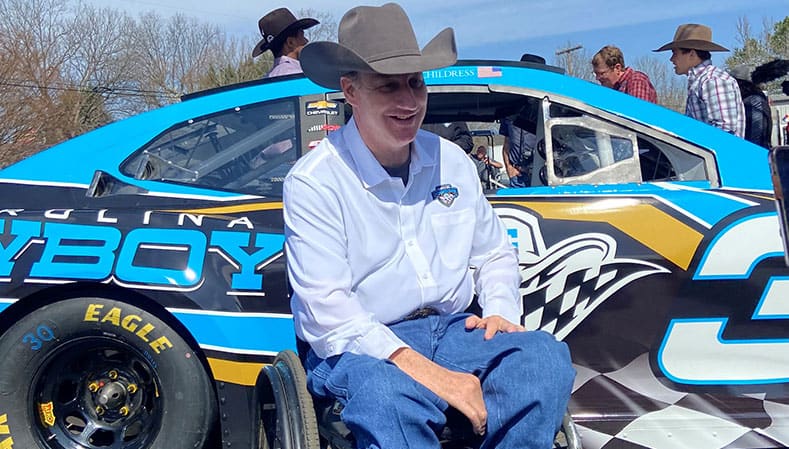
When he got his start in the sport, Jerome was a fresh-faced, easygoing and likable 19-year-old kid, leaving home to rodeo with his heroes Ty Murray, Ted Nuce, Jim Sharp and Clint Branger.
In the early 1990s, he turned pro by entering the Professional Rodeo Cowboys Association (PRCA).
He traveled with Cody Custer, a talented bull rider from Arizona, watching him win a world title. The two cowboys would drive to rodeos in the Dodge pickup that Custer had won in winning the Dodge RAM Circuit Finals sponsored by the automaker.
“He was a backwoods kid who’d never been away from home – seeing the world for the first time,” Custer said.
Custer, eight years older, first saw Davis get on a practice bull in West Texas when he was going to college in Odessa.
“Right away, he was special,” Custer remembered. “I said, ‘Who is this kid? He’s gonna be somebody!’”
The two hit it off immediately. When Davis turned 20, influenced by Custer and riders including Murray, Cody Lambert and Tuff Hedeman, he made what would turn out to be the smartest and most financially lucrative decision of his life.
At the outset, however, when Davis barely had two nickels to rub together, there was hardly any indication of a monetary upside to helping found the new sports organization.
As a kid doing what he loved being invited to join the colorful band of rodeo cowboys who were forming a new standalone bull riding league, the invitation in itself was worth all the money in the world.
The riders, seeking a better payday for their efforts, had all gotten together in a Scottsdale, Ariz. hotel room – about 15 guys cramming in, as Custer remembers. Neither rodeo partner knew if the concept of “Professional Bull Riders” would succeed.
For his part, Davis was just thrilled to be along for the adventure with heroes he idolized.
A thousand dollars seemed like a worthwhile investment since many individual rodeos were paying out maybe only three or four times that much, nothing was guaranteed, entry fees were required, and each rodeo was drawing the top bull riders, making a good payday even more challenging.
For a more established rider like Custer, forking over $1,000 to be part of the new bull riding league, even if his check was hot (meaning there were insufficient funds; he’d need to cover it by winning money at the very next bull riding), was a no brainer.
“I could spend that kind of money to travel to and enter a rodeo, fall off and get nothing,” he said. “The story today is how smart we were. We really were a group of determined guys in the right place at the right time who believed in what we were doing. We were committed to being bull riders for a living. We weren’t looking so much into the future as immediately taking care of ourselves and our families after riding for minimal money.”
It was a big honor for Davis to be invited into an exclusive bull-riding league with men he considered to be “a group of Elvises.” But he only had $500 to his name. Still, the happy-go-lucky Carolina Cowboy was all in to be part of the new league.
“I was the youngest guy there,” Davis said. “If they told me, ‘We’re gonna go rob banks!’ I’d have said, ‘Okay, let’s do it!’ I’m a kid from North Carolina who had only seen these guys on TV, and now I’m rodeoing with them!”
Davis gave $500 to PBR’s business manager, a small man named Sam Applebaum who had big ambitions for the cowboys he represented and a caustically effective confidence that got deals done.
Jerome promised Sam he was good for the balance the next weekend. He went out to California, made the whistle on a few bulls, sent in the prize money, and became the youngest owner of the new league founded at the end of 1992.
In terms of exposure, sponsorship, and rider pay, the new sport was nothing like it is today. Initially, the living wasn’t easy. Jerome and Tiffany made their home in the old homestead house on the dairy farm, leaky roof and all.
He was happy.
“There was no guy that loved the sport more than me; I was my own boss and made a living. I would get on up to 175 bulls a year. To be able to win a world title, you have to live it, drink it, walk it, talk it. It takes up every minute of your day. I was good with that.”
He almost died in 1992 when stomped by a bull, breaking his collarbone and ribs, and puncturing his lung. “I could tell I was suffocating; they ran a tube up into me,” he said.
The Carolina cowboy healed up, came back and finished in the Top 5. And in 1995, at 22 years old, he secured his name among rodeo’s elite by winning the bull riding title in the PRCA (Professional Rodeo Cowboy Association), becoming the first rider from east of the Mississippi to claim that world title.
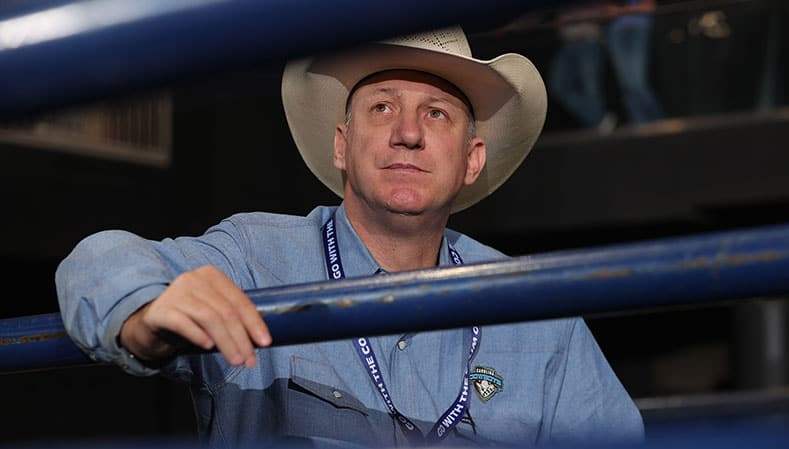
Jerome finished third in the world in 1994 and in 1996, when he won the most money to date in the PBR, allowing him to purchase the ranch from his family.
Two years later, early in the season in March, Davis was number one in the PBR standings. He’d only been thrown off three bulls all season.
In Fort Worth, he was set to face a bull called Knock ‘em Out John. They already had shared a violent history.
“He had hit me in the face once before. He’d rock you back and pull you in and hit you in the face,” Jerome said.
Tiffany was sitting in the bleachers in Fort Worth next to a girl who didn’t like that bull; he’d knocked her husband out a few weeks earlier.
Knock ‘em Out John stayed true to habit and name. He jumped forward, rocking Jerome backward. Then the bull’s momentum pulled Jerome into him. The young rider turned his head and was knocked out before he hit the ground.
“It was like diving headfirst into a swimmin’ pool without enough water,” Tiffany said.
When he came to, he knew it was bad. “I asked the doctor to take my glove off,” Jerome said. “He looked at me and said, ‘Man, I already took your glove off.’”
Tiffany met Jerome by the ambulance as he was about to be rushed to the hospital.
For the first time since they’d met, she saw fear in his eyes.
At the hospital, the doctor broke the news he’d never walk again.
“First thing Jerome said is, ‘You mean I won’t ride bulls anymore?’ He thought about that more than the walking part,” Tiffany said.
Jerome couldn’t accept the finality of the doctor’s words. Surely his legs could heal.
“I asked for the percentage. Give me a percentage. The doctor said ‘I can’t. There’s nothing there. You won’t be walking.’
I kept persisting. ‘Come on Doc, give me a percent!’
He finally said, ‘Jerome, I will give you one percent.’
I said, ‘That’s good enough.’ You know, I’m on 20 years now and still working on it.”
“I always say we are still in denial,” Tiffany said. “We are not accepting it to this day. One way to look at it is Lane Frost’s parents were there (with us.). Of course, they’d never get to see Lane again after he had passed. And Jerome is still here. We have him.”
After the wreck that left the rider also known as “Jerome Danger” paralyzed, his life would of course forever change, and Tiffany’s was thrown into turmoil. As if the stress level wasn’t high enough, the couple’s love, and her commitment, would be questioned.
Tiffany was standing in the hospital with her future mother-in-law and Jerome’s attending physician, who was outlining the next steps in caring for a 25-year-old man who’d been paralyzed.
The fall had crushed two vertebrae in Davis’ neck, and to repair the damage, surgeons had grafted a bone from Davis’ hip onto the damaged vertebrae.
The doctor was addressing Jerome’s mother, without even acknowledging Tiffany. As if she wasn’t even in the room.
He finally snidely offered, “Oh, she’ll be one of the 90 percent.” Meaning, those who, following a traumatic injury of a partner, leave the relationship.
The crude, insensitive, offhand insult just made Tiffany, then 23, more determined and resolute.
She was in love. She was loyal. She was better than that. They were better than that. God would look over and care for them, as he always had. And she knew she would continue to love Jerome with all her heart no matter the shape of his legs. There was a wedding date set, two months away.
Jerome encouraged his fiancé to heave him so she wouldn’t have to be a caregiver to him for the rest of his life. He knew he needed Tiffany more than ever, but felt it was the right thing to do.
And so, he extended to her an out, a way to go on with her life without feeling guilty.
“I tried to run her off,” he told Flint Rasmussen on his “According to Flint” podcast. “I didn’t want her to go down that road. I loved her of course. But I felt she didn’t need, five years down the road, to be hanging out with a crippled guy.”
Tiffany would have none of it.
“We were best friends before we ever started dating, and you wouldn’t leave your best friend in a situation like that,” Tiffany told the High Point Enterprise in a 2014 piece about their long and happy marriage. “So, I told him to hush up and that was the end of that.”
There would be no May wedding. It was moved to October. She became Mrs. Davis seven months following Jerome’s accident.
Tiffany had always been there for Jerome, like driving all night to help get him to rodeos far from the Carolinas. Now she was doubling down.
“We had a few cows to go on but not much,” Tiffany said. “People sent in money. It was like a gift from God. Our hospital bills got paid by donations from all these good, generous people, most of who were strangers. Our living bills got paid. Jerome said to Randy Bernard (who ran PBR at the time), ‘My bills are paid. I feel bad taking more money.’ That’s how the Rider Relief Fund got started by Randy, and it’s helped so many riders over the years.”
(In 2018, this fund, which paid severely injured riders’ medical and living bills, was relaunched as the Western Sports Foundation, adding a range of new services including access to medical specialists, counseling, and wellness services.)
Doctors told Jerome he’d only have 15 to 20 percent of his body functioning. While still in the hospital, he began dialing up riders and sponsors to plan the first Jerome Davis Invitational bull riding event. It’s now PBR’s longest-running outdoor event, well into its second decade.
For a time, Tiffany sold bull whips and trick ropes to continue to keep the lights on as the couple transitioned to finding a sustainable way to earn a living on their own without relying on the help of others.
They invested in bulls, haulers, bucking chutes and other equipment to host their own events.
Tiffany became the first woman to flank bulls in the chutes. At first, it was intimidating, especially under the no-nonsense eye of Cody Lambert. But Tiffany knew what she was doing.
She was serious and disciplined at her new job while exuding love, warmth, and positivity. And everyone loved Jerome and wanted the Davises to succeed.
Tiffany was fully accepted as a stock contractor, paving the way for many other women now seen preparing bulls for competition at PBR events today.
“I’m not the smartest person, but I know I’m smart enough to do something I’m passionate about,” she said. “This is a lot of hard work for what you’re making. But the friendships and lessons in life you get, I wouldn’t trade for anything. I’ve always thought the most important thing in life is how you treat those people around you. The PBR is such a good group. We have a deep love. It sounds corny, but it really is like a family.”
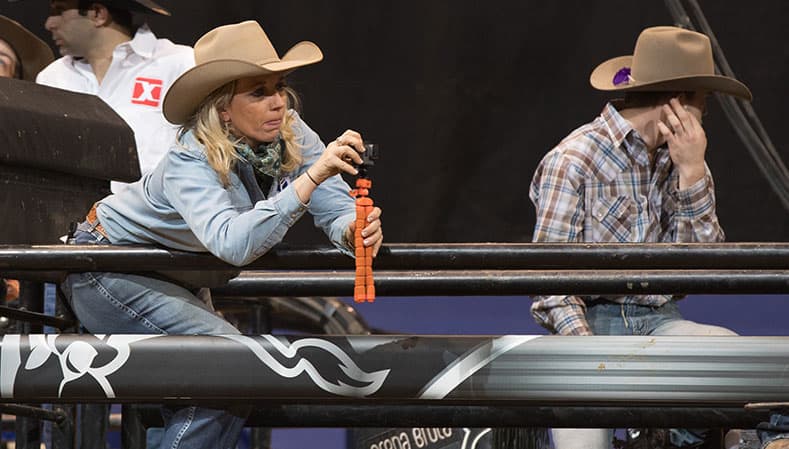
As the PBR family welcomed the new stock contractors, led by a hardworking brassy blond who loved what she did, the couple’s financial lot would eventually improve markedly as a result of Jerome’s decision a little more than a decade prior to kick in every dollar to his name to join his fellow riders in forming a new bull-riding sport.
In 2005, a company called Spire Capital would acquire the PBR, producing a windfall for the founders.
Cody Lambert, one of the heroes Jerome looked up to when he first joined the 19 other cowboys forming a new sport and now coach of the Texas Rattlers, got to make the best phone call of his life to inform Jerome that he was about to become a millionaire.
Jerome and Tiffany used part of the windfall to build on the ranch an impressive western-themed, three-story log cabin, complete with an elevator. Its roof would never leak.
“For a while, every time it rained, I’d still want to look for a bucket to catch them drops, even when we had the new house,” she said.
“Best thousand bucks I’d ever spent,” Jerome added, referring to the money he scraped up to invest in the audacious new bull-riding league.
At first, after Jerome was hurt, Tiffany’s faith had been rocked to the core. She’d question why it was Jerome who was hurt. He was one of the good guys!
Then she began to understand the mysterious and challenging workings of God’s divine will.
Jerome’s accident did have a purpose. He has helped and inspired many more people in a wheelchair than he would have if the accident hadn’t happened, she believes.
Today, the 5,000-seat Davis Ranch Arena on their property hosts a handful of rodeo and bull riding events each year, including Christian Junior Rodeo, Tiffany’s favorite event of the year because the Davises give back to the community just as the community helped when they most needed it.
On the premium experience tours, Jerome and Tiffany feed their guests a stomach-pleasing fare of homemade North Carolina barbeque with chicken dumplings, potato salad, and mac ‘n’ cheese.
The dessert table is laid out with trays of banana pudding, white chocolate cheesecake, and persimmon pudding – “something old southern ladies make, which is why Cracker Barrel don’t have it,” Tiffany said.
The food is as good and satisfying as the bull-business education, homespun wisdom, and laughs served up by two of the genuine characters making the PBR family so special, a couple bound by a special love and enduring faith that spills over to their community, their sport, its fans and of course, the animals.
Reprinted with permission from Love & Try: Stories of Gratitude & Grit from Professional Bull Riding (Cedar Gate Publishing), now available on PBRShop.com with proceeds supporting injured bull riders through the Western Sports Foundation.
© 2022 PBR Inc. All rights reserved.


